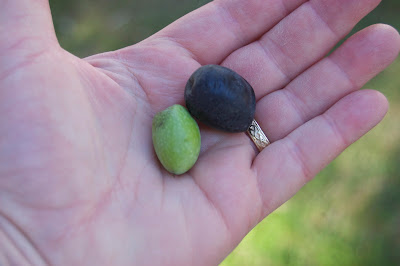The California Institute of Technology, a.k.a. Caltech, has a lovely canopy of mature olive trees shading a central corridor of its tony, ivied campus. But only in the last few years have they made an effort to collect the olives that create a monounsaturated mess every autumn. Nowadays the school, which is better known for its affiliation with NASA and Jet Propulsion Laboratories than for olive production, holds an annual harvest that is open both to students and staff and to the outside as well. Since I’d never picked olives before, I figured it was high time I gave it a try.
These are mission olives, which Franciscan monks from Spain planted at the missions they established up and down the Pacific coastline in the late 1700s.
The first thing I learned is that, despite their diminutive size, olives hurt like the dickens when they pop off the tree and hit you on the head, cheekbone or some other prominent part of your body!

Teams of volunteers tackled each tree, with one person climbing the ladder to comb the olives off the branches with what essentially looked like a leaf rake, while the others remained below to collect the fallen fruit. Check out these amazing ladders, with a single support post and rungs that taper from an extra wide stance to quite narrow at the top. (By the way, note the cannon in the background–it appears to be aimed squarely in the direction of Pasadena Community College, just a couple of blocks away. Coincidence…?)

Most of the olives raked from the trees landed on the burlap tarps, but quite a few bounced off our heads and either landed in the grass or skipped across the pavement. A number of volunteers brought their small children with them, little sprouts who chased the errant olives and flung them happily into the tarps and waiting buckets. It was a real Tom Sawyer kind of day–we had so much fun we kind of forgot we were working. Of course, I’m sure we’d view it quite differently if this was our job in and day out.

At noon we recessed to enjoy a lavish buffet of olive-based Mediterranean fare, including moussaka, hummus, tabbouleh, tapenade, gyros and kalamata bread. There were also large pans of assorted olives (I was wishing I’d brought a zipper bag with me!), an array of olive oils to sample and escargot cooked up on the spot and served to us on rounds of baguette. I should have photographed the layers as I piled them onto my plate. I wanted a taste of everything, and I got it! For the most part it was incredibly healthy stuff, and it was all quite good.

Lunchtime brought a little messy recreation as students with hands coated in olive oil engaged in a tug-o-war in the center of the sun-dappled grove. A woman bearing a large tin of olive oil gave each student’s hands a liberal glug-glug-glug before the tugging commenced. The winning team (pictured) chanted “meat truck! meat truck! meat truck!” in between battles. Nothing against my vegetable-loving brethren, but I’m not surprised by who won. My guess is the victors got to pick which food truck was going to be visiting campus. The carnivores carried the day.

The event featured an olive-pressing demonstration, a job that seems pretty low-tech, considering that it was taking place on a campus where students train to work in space exploration, among other extraordinary engineering pursuits. This is a more modern version of the ancient screw press, not as quaint as the giant stone wheels you still find doing the job throughout the Mediterranean. It takes about 11 pounds of olives to yield a liter of oil, so rather than pressing all the olives this way, our harvest will be shipped to Santa Barbara for oil production. As for learning the technique of brining olives, our brining expert was sick that day, so this lesson will have to wait for next year’s harvest.

Two down–a gazillion to go!
It was instructive learning through hands-on experience what autumn brings for those who live amongst the olive groves that cover the Mediterranean. Olive harvesting combines long hours of what is essentially tedious labor with a great social opportunity. When you pitch in with a group to do this job, you find that you have a lot of time to talk as you work. And you come to understand how a collective effort like this can be so central to the life of a community.
Caltech’s students may be preparing themselves for the most high-tech jobs on this planet and possibly a few others, but I appreciate their cheerful embrace of one of the oldest and humblest chores on Earth.
To hear the story behind how Caltech students spearheaded this effort a few years ago, check it out on NPR. If you’re interested in keeping up with the project–and participating next year–visit Caltech’s olive harvest website for more information.






















